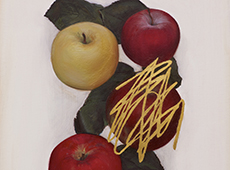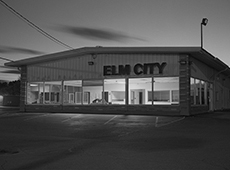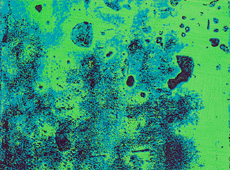The more I understand the backstory of what I’m looking at, the more I know what’s significant and how to use visual language…
This is the fourth installment in a Tilted Arc ongoing feature, Women in the Landscape—conversations between women photographers whose work focuses on the land.
This conversation is with Karen Halverson, an artist that has been photographing for over 30 years whose work is in many prestigious collections including the San Francisco Museum of Modern Art, Smithsonian American Art Museum, the J. Paul Getty Museum, Beinecke Library at Yale University among others. She is based in the Hudson Valley of New York.
You describe your work as photographs that “comment on how we encounter, occupy and alter the land.” Can you talk a bit about your own connection to landscape and why your work focuses on encounters, occupation and alteration?
For me, ideas most often arise when I’m out there with the camera and, later, in the editing process. I work more intuitively than conceptually. I grew up in the East. When I was five, my mother, a widow, took her kids on a three month, 8,000 mile car trip around the American West. I now believe that epic trip affected me deeply. It introduced me to the wider world, while establishing the West, in particular, as a destination. It also provided me with the model of an adventurous woman, comfortable wandering the landscape.
I was living in New York City with my own family when I finally found the time and money to go west to photograph. That was thirty years ago and I’ve been photographing there, on and off, ever since. On that first trip, I just wandered, without itinerary or conscious preconception. Early on, I realized I was not interested in making yet another beautiful photograph of a dramatic vista or an ironic photograph juxtaposing nature and culture or, for that matter, another cri de coeur about a ravaged landscape. I was drawn to human artifacts in the landscape — perhaps in reaction to the tradition of seeing landscape as “pure,” or because human artifacts establish a sense of time — the here and now, or because I have a background in cultural anthropology. So I took it all in — vistas, rivers, cars and trucks, dams, signs — without self-censorship. Anything else felt like a deception.
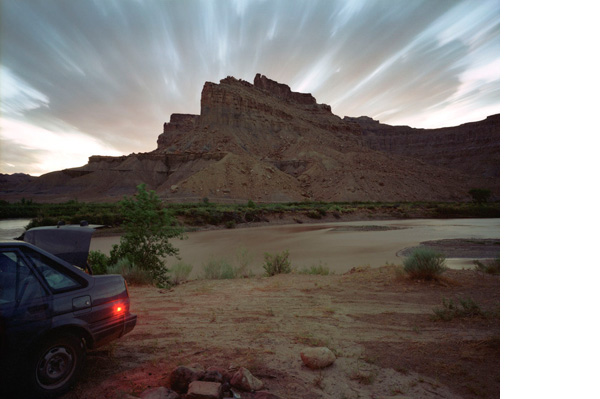
“Green River, Utah,” from the series,
© Karen Halverson. Courtesy of the artist.
In time, I found I wanted more structure, more coherent content, and, in the case of the Mulholland series in Los Angeles and the Colorado River series, geography provided that. I spent a couple of years on each of those series, read a lot of history in the process, and became acutely aware of water issues in the arid West. So, in the case of these two series, my photographic strategy was affected by having a grasp of Euro-American settlement in the West. Landscape reflects both natural and human history. Content is important to me. The last photograph in my Colorado River series shows an empty riverbed, water entirely consumed. The photograph is descriptive, but it is also symbolic of our exploitation of this once mighty river.
I was drawn to human artifacts in the landscape — perhaps in reaction to the tradition of seeing landscape as “pure,” or because human artifacts establish a sense of time…
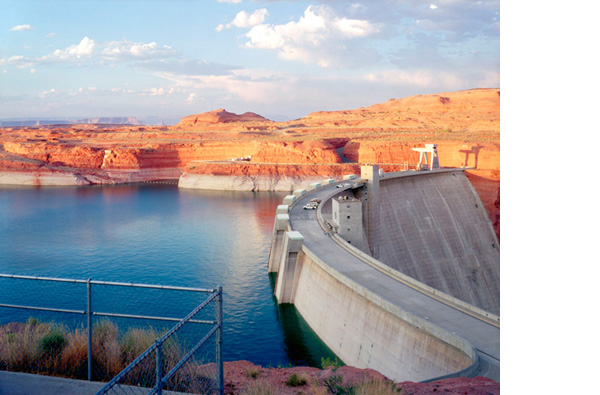
“Glen Canyon Dam, Page, Arizona,” from the series,
© Karen Halverson. Courtesy of the artist.
In recent years, I’ve adopted a couple of new approaches—more on that later—but they both still involve human artifacts in the landscape.
You mention the landscape reflecting both natural and human history and how you spent a lot of time reading the history of some of your subjects. Can you talk a bit about how reading that history impacted the work (if it did at all)? And, how the history of this genre, landscape photography, is so clearly defined in the American West. How did the history of the medium impact your decision to also head west to photograph?
I’ll start with your last question. I knew that landscape photography had a deep history in the American West, but that did not influence my desire to go there. My need–and it was a need–was personal, for reasons I described earlier.
I have always loved that photography is a visually expressive medium while also, as I use it, reality-based. I love the treasure hunt, coming upon situations I could never have imagined or made up. But while the camera is good at recording what things look like, it is not good at providing information. Landscape—and therefore landscape photographs—reflect natural and human history, but they do not tell all. On the contrary, photographs tend to be narratively ambiguous. With my photograph, “Davis Gulch, Lake Powell, Utah,” we see a very tall sandstone cliff, some water, and a few small white plastic chairs in what looks like an unlikely spot. We don’t know the specific story, but we understand that the chairs indicate a human presence. What I would hope is that the photograph makes you want to know more, to learn that once verdant Glen Canyon was flooded to create Lake Powell, to learn that the water allocation treaties were made with a misunderstanding of typical rainfall in this arid area, to learn that the reservoirs on the Colorado are now at record low levels. etc. The more one knows, the more the photograph resonates. Same thing when I’m out there. The more I understand the backstory of what I’m looking at, the more I know what’s significant and how to use visual language — not just for pleasure — but to raise questions. What kind of place is this, why are those chairs there, and what do they signify in their context?
The more I understand the backstory of what I’m looking at, the more I know what’s significant and how to use visual language — not just for pleasure — but to raise questions.
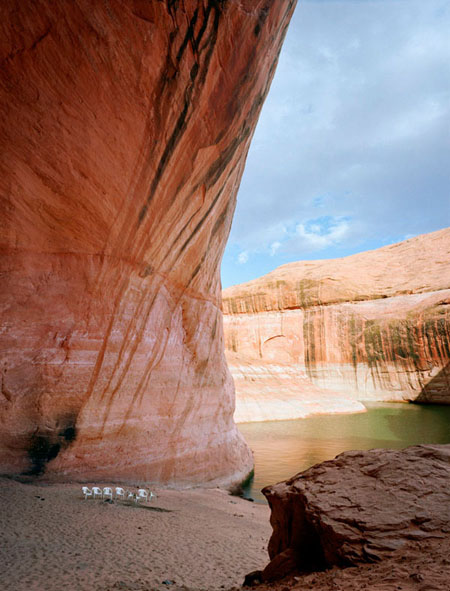
“Davis Gulch, Lake Powell, Utah,” from the series,
I’ll switch gears here and speak about my Dakota series in which, to my own surprise, I used a somewhat conceptual approach, based on a prior understanding of history. I took a variety of cameras when I drove to the Dakotas, having no idea what or how I would photograph. I knew the land would be flat with broad vistas. The panoramic camera seemed the obvious response. I tried it; right away, it bored me. I wasn’t saying anything but the obvious. But then I realized that nearly all the roads ran straight, north/south or east/west. Often they were at regular, one-mile intervals and numbered. In the midst of soybean fields, there was 229th Av. Rows of trees called “shelterbelts” also ran in cardinal directions. It dawned on me that this land configuration was the result of the Homestead Act, passed under Lincoln in 1862. This is the Act that offered settlers a quarter section of land (160 acres)—usually a rectangle—in exchange for “improving” it. “Improving” meant establishing a home and replacing native grasses with agricultural crops. So I pulled out my Hasselblad and made square images, put the horizon line straight across the middle of the frame, and positioned any prominent man-made features dead center. I sought out geometry wherever I could find it. I was using format and composition to refer to the parcels of land I saw before me. I found it very refreshing to be photographing with a new, site-specific strategy even though I had no idea how I would feel about the results.
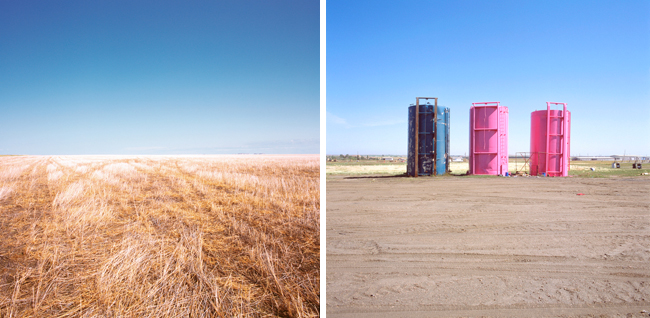
Left: “Scenic, South Dakota.” Right: “Dickinson, North Dakota.” Both from the series,
© Karen Halverson. Courtesy of the artist.
In much of my earlier work in the West, I used human artifacts in the landscape, large elements of infrastructure like dams, and idiosyncratic elements like the white plastic chairs in Davis Gulch, to comment on our relationship to the land. In the Dakota series, while I was still interested in content, I used compositional strategy to reflect on the historical use and the current appearance of the land.
So much of what you describe here resonates. I am always curious to ask, especially of photographers, whether they want their pictures to answer questions or raise questions. For me, that has always been the dividing line between documentary and fine art work. I think our perception of the camera’s role is to record, yet photographers know how much is left out of the frame, how by simply cropping the world into a rectangle or square, we are severely altering what is reality. It seems like, for example, in “Davis Gulch, Lake Powell, Utah,” that you need the viewer in one sense to be convinced that this is a real place, a real situation that you came upon, to as you say, raise questions about why the chairs are there, and more. But, as you also say, photographs are narratively ambiguous. Can you expand a bit on this tension (which I also believe exists quite distinctly in photography)? For instance, how much you decide to exclude from the frame?
I think we’re all beyond the point of thinking that photographs tell the truth, for the reasons you mention, because of the various predilections of cameras, film and digital media, and because of the tools we use in the darkroom and now with Photoshop.
As I think you are suggesting, if a photograph were not in some way ambiguous, it would not raise questions. It might confirm what we already know. Or it might celebrate or condemn a situation or an action, the significance of which we clearly understand — the crowds cheering as the ball player slides into home plate. These kinds of photographs all have their place, without a doubt.
Here’s how I work. Something will grab me. If it’s not going anywhere, in other words, if there’s time, I’ll move around to explore how I want to use that thing — the white plastic chairs — to make a photograph that seems to me to have significance beyond what is literally there. With the photograph we’ve been discussing, here’s what happened. I was maneuvering a speedboat up the canyon when I saw the chairs against the canyon wall. Right away, I knew I needed to make a photograph. A moment later I came upon a houseboat full of people, beached near the chairs, having a high old time. Right away, I knew I did not want them. The large rock you see in the right foreground conceals the houseboat. So why? As it is, the photograph has a degree of narrative ambiguity and of symbolic significance. Had I included the houseboat crowd, the photograph would have been all wrapped up in a way, an anecdote. And that didn’t interest me. Did I lie? No more than when we say something, but not everything. Which is to say, what we can’t help but do all the time.
It’s interesting to think about how photographs differ from other visual images. Of course, since the first photographs were made, painters have worked from photographs and often you can see it in the work. Look at Degas’ paintings from the 1880s and those of the contemporary painter, Eric Fischl. Objects and bodies are fragmented by the edge of the frame. Human gestures are so specific as to have been caught at 1/125 of a second. I don’t think these kinds of paintings would have been made before 1839.
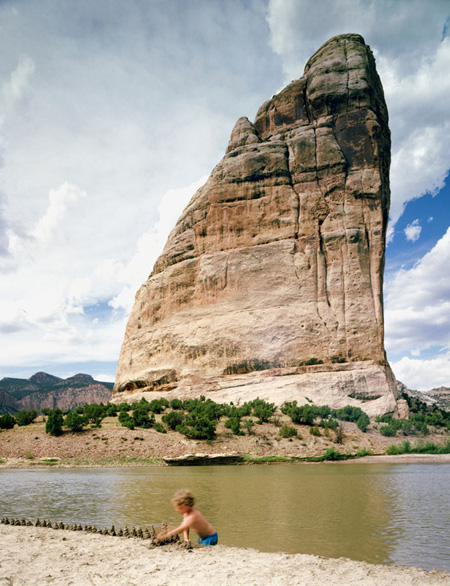
“Dinosaur National Monument, Colorado” from the series,
When I started photographing in the 1970s, it seemed practically a moral imperative to alter nothing, to make photographs of what was there, even though we understood that the frame altered the scene by inclusion and exclusion, that the world was really not black and white, etc. Digital, of course, has changed the game completely. I remember when Max Frankel, then editor of The New York Times, wrote that, with the coming of digital, photography had lost its evidentiary power.
A few years ago, I made a photograph near where I live in the Hudson River Valley. I was in somebody’s yard where a lot of kids’ things were strewn on the ground. But shrubs prevented me from backing up enough to include all the colorful plastic things. I didn’t want to “arrange” them. So, I picked them up, turned my back, and tossed them over my shoulder into the picture area. I did that three times until I was satisfied with how they fell. What kind of truth is that? The sense of the scene is intact, and the photograph is made stronger by my “accidental” rearrangement.
Recently, and for the first time, I have begun introducing things into the landscape for the sake of the photograph — more on that later. It’s a definite shift in approach for me and I thought it would feel uncomfortable at first. But, immediately, it felt liberating, as though a weight had been lifted, the weight that ties us to the world as we find it. I’m still working on what the resulting photographs do or do not mean. Or what they signify, to use the current lingo.
The tension you mentioned? We know all the ways in which a photograph does not simply make a record. The world is the raw material from which we make images. I hope my photographs communicate something about the world as I find it. But I also hope the choices I make, visually, support my point of view about the content. It’s a fabulous dance!

“En Route to Mt. Askja,” from the series,
© Karen Halverson. Courtesy of the artist.
Orion recently wrote about your series, “Mulholland’s View,” a project made on Los Angeles’ famed road, “Karen Halverson…focuses her camera and our attention on what we mostly miss while cruising the skyline.” Is it important to you to focus our attention on what goes unnoticed?
I think Bill Fox’s premise in the quote above is that we tend to look at the big picture, the VIEW. Anyone who has made visual images knows, though, that a detail in the foreground puts you, the viewer, at the scene. So, by putting the viewer right there, the foreground detail establishes that we are seeing how things looked from a specific vantage point at a specific moment in time. I have never been very interested in photographs that seem as though they are trying to look eternal. The view of the Grand Canyon may not change much from day to day, but what happens on the rim changes moment to moment. I’m interested in finding the detail that puts us there in the here and now, set against whatever the bigger picture might be.
I’m interested in finding the detail that puts us there in the here and now, set against whatever the bigger picture might be.
When I taught photography, I used to encourage what I called “a democracy of interest” in the frame. To the extent that I taught composition, I did so by asking “Where does your eye go in the photograph and how does that affect your interpretation of the photographic content?” “A democracy of interest” is probably a misnomer because, of course, not everything is of equal importance. But the point — usually — is to encourage the eye to roam the frame, to take in all the visual elements and their relationship to each other.

“Saline Valley, California,” from the series,
With regard to your question, I have to ask unnoticed by whom? If it is the big picture that is what most people see first (or only), it is the detail, quirky or otherwise, that gets my attention and gives me a handle on which to hang the picture.
Here’s another way to respond to your question. I feel that from the very beginning of my journey as a photographer, I knew not to censor what I saw. Somehow I was relatively free of preconceptions about what a place should look like and therefore what a photograph of that place should look like. I remember once seeing a friend’s photograph of his parents’ living room with the vacuum cleaner hose strung out on the rug. That’s not a remarkable thing to see, but to me it was wonderful that he had thought to make a photograph of it. Sometimes when I’m working on a specific body of work, I am looking for details that will provide greater substance, to help tell the story. Most of the time, I’m as interested in the contrail as I am in the sky, if not more so.
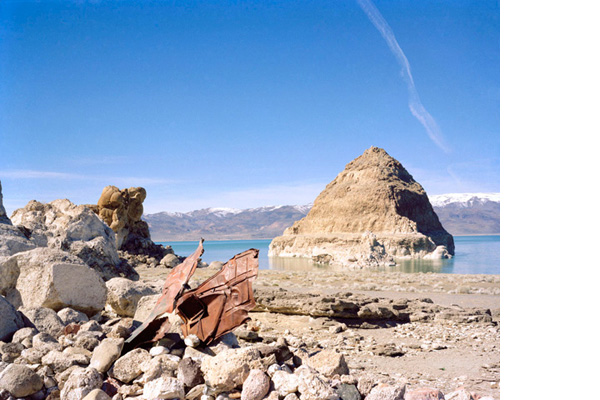
“Pyramid Lake, Nevada,” from the series,
© Karen Halverson. Courtesy of the artist.
I have always loved the tension created by the photographic frame. The conventional rule is that you use the frame to contain what’s inside, not to draw the eye to the edges of the frame where it might “spill” out. As you no doubt know, if you use a view camera, as I have for many years, you can’t see the image on the ground glass as you trip the shutter. I have a photograph made at Lake Powell, Utah, in which a man wearing a hot pink sweater is in motion, half way out of the frame. The photograph has a strong central element, a houseboat, and some random sewage hoses in the foreground. The man’s pink shirt—cut in half by the frame—is the unexpected bolt of energy that I couldn’t have planned, but that I would never sacrifice for the sake of a neat and tidy composition.
And that makes me think about cropping. I mentioned earlier that, in the 1970s, it felt verboten to introduce anything into the image area. The same goes for cropping. The black line around the frame that was de rigueur back then “proved” that one hadn’t cropped. We were seeing it all and it was “real.” We think we know better now, but it is still true that I can hardly bear to crop anything the camera gave me, whether I intended it or not. To get back to your original question, this is true even when the vagrant element is something I had failed to notice. So much the better. The camera, as a tool, is free of our ideas about what constitutes a photograph. Sometimes it gives us more than we bargained for.
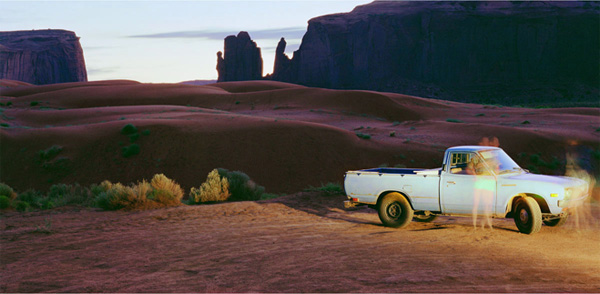
“Monument Valley, Utah,” from the series,
“Sometimes when I’m working on a specific body of work, I am looking for details that will provide greater substance, help tell the story.” Can you talk about some of your new work and how you made the transition from “looking for details” to actually intervening into the frame to stage what is being photographed?
I have long been more interested in the photographic series than in the individual photograph. Because photographs are not inherently narrative, the series is better able to “tell the story.” In a series, individual photographs play off each other on the basis of both content and form. So, in the quote you cited above, what I meant is that sometimes, there’s an important detail that is missing from the series and so I need a photograph to bring in that detail, to round out the story.
As you know by now, I don’t generally go out to photograph with a preconceived concept. For me, ideas arise in the process of making work. The new work started a few months ago when I found pieces of plastic tape attached to trees in South Carolina, hot pink strips punctuating the greens and browns of magisterial oaks. Property markers, yes, but also ribbons, adornment! Back home in New York State, I searched for plastic strips in the woods but found very few. It was March, the landscape brown, the sky mostly gray. I craved color and the hardware store had it. For the first time in many years of photographing landscape, I took to decorating it. We humans have always made our marks on the land one way or another. We claim territory, we designate what’s to be preserved or removed, we indicate the route, and sometimes we alter or add to what’s there solely for visual and sensual pleasure. (What is a garden, after all?) I well remember seeing Christo and Jeanne-Claude’s installation of yellow umbrellas in Southern California. I experienced how their bright color and bold form called attention to every other visual element in the landscape. Here too, with these new photographs, I find that a single stroke of pink tape draws the eye to whatever other colors, lines, and forms are there. So, to return to your question, it is a detail, in this case an introduced detail, that draws us into and around the visual field of the photograph.
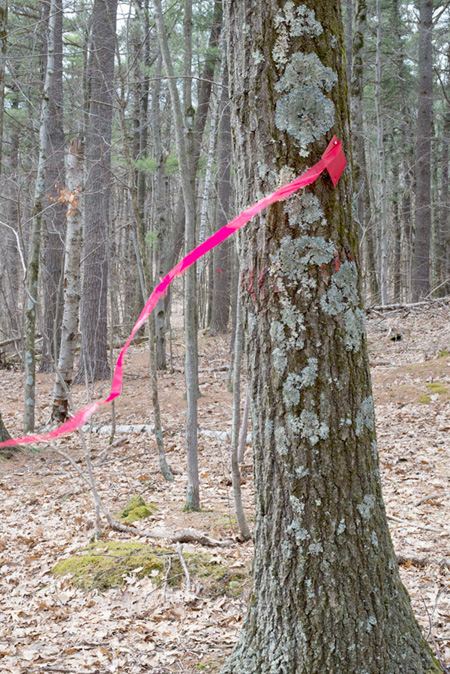
“Untitled (4-28-14-78),” from the series,
© Karen Halverson. Courtesy of the artist.
The process feels a bit like drawing, though not on a blank canvas. I wander the woods with my pack of tapes until something stops me. Then I consider how I can very simply accentuate or elaborate upon an aspect of what’s there. After I’ve made that first image, I circumnavigate the scene and, more often than not, I find a vantage point I prefer, an unexpected view that presents itself.
So far I have limited myself to the tape as a drawing tool. While not natural to the landscape, it is commonly found there. Not only is it colorful, but it’s light, flexible, translucent, and subject to the wind. I introduce it, but then to some extent, I set it free. I have no idea how far I can go with this series or in what direction it may take me. But I just came home from the hardware store with an assortment of new and different tools for making a mark in the landscape.
It was interesting to me that the transition to introducing something to the landscape was not hard. A bit strange maybe, but right away, it felt fun, whimsical, a welcome change. As I look back, I see that the seeds for this work are there in my California trees series in which colored poles, tape, and netting make occasional appearances.
With this series, finally I am interested in photographing where I live. It has always felt like a disconnect to live in one place but to feel that I have to get on a plane to make photographs that matter to me. Location is not central to this work. It is the detail of the introduced element, together with its effect on our experience of the whole that, I think, holds these images together.
It sounds like you’ve made a huge transition. Earlier, in talking about the work in Colorado, you said, “The more one knows, the more the photograph resonates.” This new work seems more about a response to form and color. I’m not sure if this is the case for you, but I’ve fielded questions about the role of the artist’s hand in photography, especially with the amount of equipment used to make photographs. Is there any difference for you in making these photographs in relation to the physical aspect of placing the tape? Do you feel, in any way, physically more connected to the subjects you are photographing?
Yes, this new work seems to rely more heavily on form and color than it does on content. At first, I worried a bit that it lacked gravitas. But I’m delighted when anything holds my attention, as this approach does, so I’ve left my worries behind. Besides, as I look back, I see that it’s not an entirely new approach. One evening in 1987, while photographing in California’s Alabama Hills, I felt the need for a visual anchor in the foreground. I turned and there I saw my car, doors flung wide open. I made the image with the car dangling half out of the frame. After that, although I never “placed” the car for the sake of the image, I included it in photographs occasionally. I sometimes incorporated car headlights and my own blurred self into the image as well. I realized that the car was a symbol of our presence in the landscape. But I also saw that it was a self-reference, even if that’s not necessarily clear to the viewer. The elements I am introducing now are, among other things, a self-reference. It’s clear I’ve been there, entered the scene, and made my mark.
So, the role of the hand? Now, in addition to looking for form, light, etc., I am looking for something that invites me to interact with it, using tape or another material. I don’t know that I feel more connected to what I’m photographing than I otherwise would. But I do feel that when I introduce something to the landscape, I am expressing appreciation for what’s already there. My additions are modest, gentle, affectionate. A flourish or an ornament, like a musical grace note. The landscape still has the upper hand.
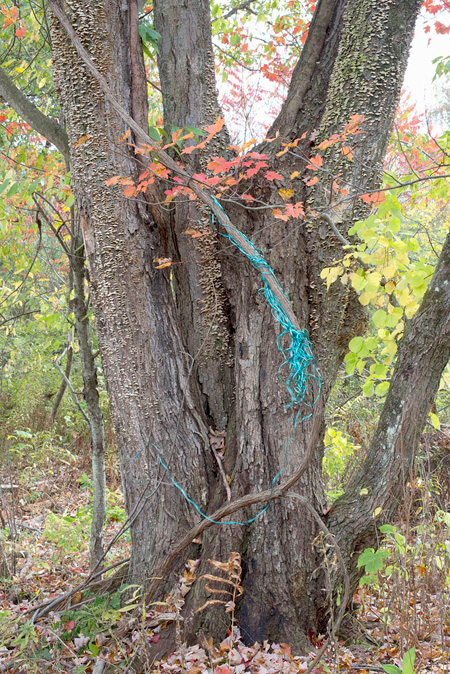
“Untitled (10-15-14-2242),” from the series,
© Karen Halverson. Courtesy of the artist.
You mention equipment. I always aim to go out with at a minimum, one camera, one lens. Different ones under different circumstances, but only one at a time. The only addition here is my backpack full of tapes, etc. Physically, there’s a limit to what I can do. I don’t work with an assistant. I don’t bring a ladder. I’m in the woods with only what I can easily carry. Early on, I decided not to use a hammer, nails, or any adhesives. I’m only using materials I can introduce by hand, often using a tree as scaffolding. It’s interesting how one establishes parameters as a series unfolds.
You mention form and color playing a more prominent role in this series than content. I find that true with the materials I am using as well. I am using only materials that appear abstract, that have no obvious references or connotations, nothing patterned, too decorative or too obviously functional.
I mentioned earlier that Christo came to mind as I began to work on this series. But I should also mention David Hockney, whose work I have adored for decades. His painting, “Mulholland on the Way to the Studio” inspired my Mulholland Series.

“Above Universal City,” from the series,
© Karen Halverson. Courtesy of the artist.
I find extraordinary Hockney’s free and bold use of color, his willingness to try any material or technique. In his recent large paintings of the Woldgate Woods in Yorkshire, for instance, a road may be outrageously mauve, a tree chartreuse, the ground blue or orange. He is willing to be joyous. I feel that with this new work, I am too.
Editor’s Notes:
To download a PDF of this interview, please click here.
To follow the Women in the Landscape series in its entirety, click here.
To purchase Karen’s book, Downstream: Encounters with the Colorado River, visit the University of California Press’ website by clicking here.
Subscribe to Tilted Arc
If you like this story, please consider subscribing. We are sticklers for privacy.
We will never sell or share your e-mail address.

